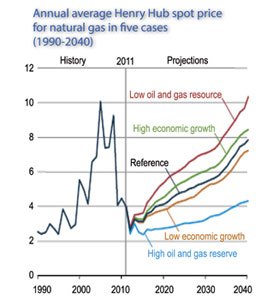Manufacturing News
Cheap energy—but for how long?

|
|
Projections for the Henry Hub price of natural gas vary significantly depending on economic growth and the level of oil and gas reserves. Source: US Energy Information Administration. |
“Dropping natural gas costs are, in large part, deterring retrofits of existing gas burning equipment because there is no reasonable payback associated with the capital expenditure of retrofits,” explains Mary Frances Stotler, sustainability coordinator for The Dennis Group. “The flip side of the coin is that low natural gas costs are influencing fuel switching for new equipment, shifting the market from electric to gas where practical.”
“The replacement of older equipment, which has reached the end of its useful lifecycle, is still seen as a large target for savings as they are replaced with higher-efficiency units,” says Tony LaShay, business development director for Excel Engineering.
Location can also play a major role in energy pricing. “Processors want to build their new facilities in areas of the country that offer low utility costs and incentives [usually in the form of tax rebates],” says Troy McOmber, vice president of Fisher & Sons Design/Build. For example, Southern Idaho has attracted major processors due to a number of factors including quality of life, a proactive business environment and low energy costs.
Most new facilities use equipment that has highly efficient energy demands, takes every advantage of systems that reclaim energy for reuse and utilizes highly efficient materials in the building, mechanical and electrical systems. Retrofitting older facilities will likely trend upward, but the decision to make energy modifications to an older plant is a difficult equation with multiple variables. One major hurdle is deciding at what point it would be better to build a new facility with the latest technology and equipment versus putting more and more money into an older plant that will never meet the energy efficiencies of a newer building and equipment. There is a line at which one approach makes sense over the other, but it is extremely difficult to quantify and may differ from processor to processor, according to McOmber.
“The lower cost of energy has not really had much impact on retrofits,” says Chris Jarc, Hixson Architecture & Engineering project manager. Natural gas is always cheaper than electricity or oil, with propane a distant third. Companies want the latest and greatest equipment (which will be as efficient as possible) when retrofitting, whether or not they are actively trying to conserve energy.
“In fact, the 2012 International codes [e.g., 2012 International Energy Conservation Code] and 2010 ASHRAE 90.1 are more of an issue than the cost of energy and are driving some compliance efforts,” adds Jarc. “The codes sometimes require more energy-efficiency actions than would typically make sense.”
“Common sense retrofit projects that have a payback and fit an owner’s criterion [say one to four years] are still sought after,” says Karl Landgraf, principal of The Dennis Group. “The advent of fracking and the resulting increase in natural gas supplies and lower gas prices will mean that some retrofits no longer make sense.”
“I am aware of projects to reclaim heat from process equipment in existing facilities where the ROI is less than two years,” says Jerry Rudie, senior project manager, SSOE Group. “Reduced energy costs make getting these projects approved tougher.” Generally speaking, alternative energy, zero waste and LEED projects in existing facilities haven’t been viewed as cost effective, but energy-reduction projects with proven ROIs do make sense.
Looking for a reprint of this article?
From high-res PDFs to custom plaques, order your copy today!








